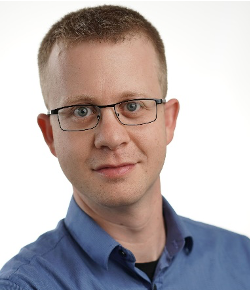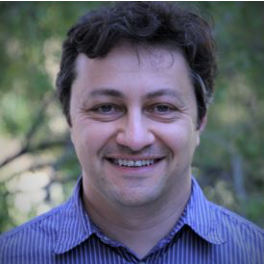
Goddard Space Flight Center, Greenbelt, Maryland 20771
ENGINEERING COLLOQUIUM
Monday, August 17, 2020 / 3:30 PM, On line only
Moran Bercovici and Edward Balaban
"Fluidic Shaping of Optical Components for Earth and Space Applications"
ABSTRACT -- Current methods for fabricating lenses or mirrors rely on mechanical processing - such as grinding, machining, and polishing. The complexity of these fabrication processes and the required specialized equipment prohibit rapid prototyping of optical components and places a very high price tag on large lenses and free-form optics.
In the first part of our talk, we will present a simple method that leverages the basic physics of wetting phenomena and hydrostatics for rapidly fabricating a variety of lenses (e.g., spherical, cylindrical, saddle, bi-focal, doublets, and aspheres) with optical-grade surface quality and without the need for any mechanical processing. A key component in the process is the elimination of body forces through neutral buoyancy conditions yielding a method that is scale-invariant: it can be used to produce lenses of any size, while preserving surface quality. The method is inexpensive, does not require specialized equipment, and can be implemented using a variety of curable liquids.
In the second part, we will discuss a collaboration between Technion and NASA that seeks to leverage the technology for creation of optical components in space. One direction being explored is in-space construction of large telescopes, potentially allowing to overcome current launch constraints. Optical components for such telescopes, including lenses and mirrors, would be deployed from a liquid container and then solidified — or remain in their fluidic state. The latter would allow dynamic modification of their optical properties. A second direction would be applying similar techniques for in-space manufacturing of high-quality optics that are not achievable using 3D printing.
SPEAKERS --

Moran Bercovici is an Associate Professor of Mechanical Engineering and Biomedical Engineering at Technion — Israel Institute of Technology. His lab combines experimental, analytical, and computational tools to study problems characterized by coupling between fluid mechanics, heat transfer, electric fields, chemical reactions, and biological processes. He is equally interested in understanding basic physical mechanisms and in leveraging them to create new tools and technologies across different disciplines. His current focus areas are in rapid prototyping, adaptive optics, microscale flow control, configurable microstructures, and lab-on-chip systems. Moran holds a PhD in Aeronautics and Astronautics from Stanford University, worked as postdoctoral fellow at the Stanford School of Medicine, and was a Harrington Faculty Fellow at the University of Texas at Austin. He has authored and co-authored over 50 articles in top peer-reviewed journals, is an inventor with more than 20 patents, and is the recipient of several awards including the EU European Research Council Starting Grant and the Blavatnik Prize – considered one of the most prestigious awards to young scientists in Israel.

Edward Balaban is a researcher at NASA Ames Research Center in Mountain View, California, whose professional interests involve robotic systems, automated sequential decision making under uncertainty, and systems health management. He is particularly interested in enabling ambitious science and exploration missions via intelligent control and, generally, finding solutions to challenging NASA problems on the intersection of disciplines. His current work is focused on the Volatiles Investigating Polar Exploration Rover (VIPER) lunar mission. Edward holds a a PhD in Aeronautics and Astronautics from Stanford University.
Colloquium Committee Sponsor: Brent Warner, NASA-GSFC
Engineering Colloquium home page: https://ecolloq.gsfc.nasa.gov